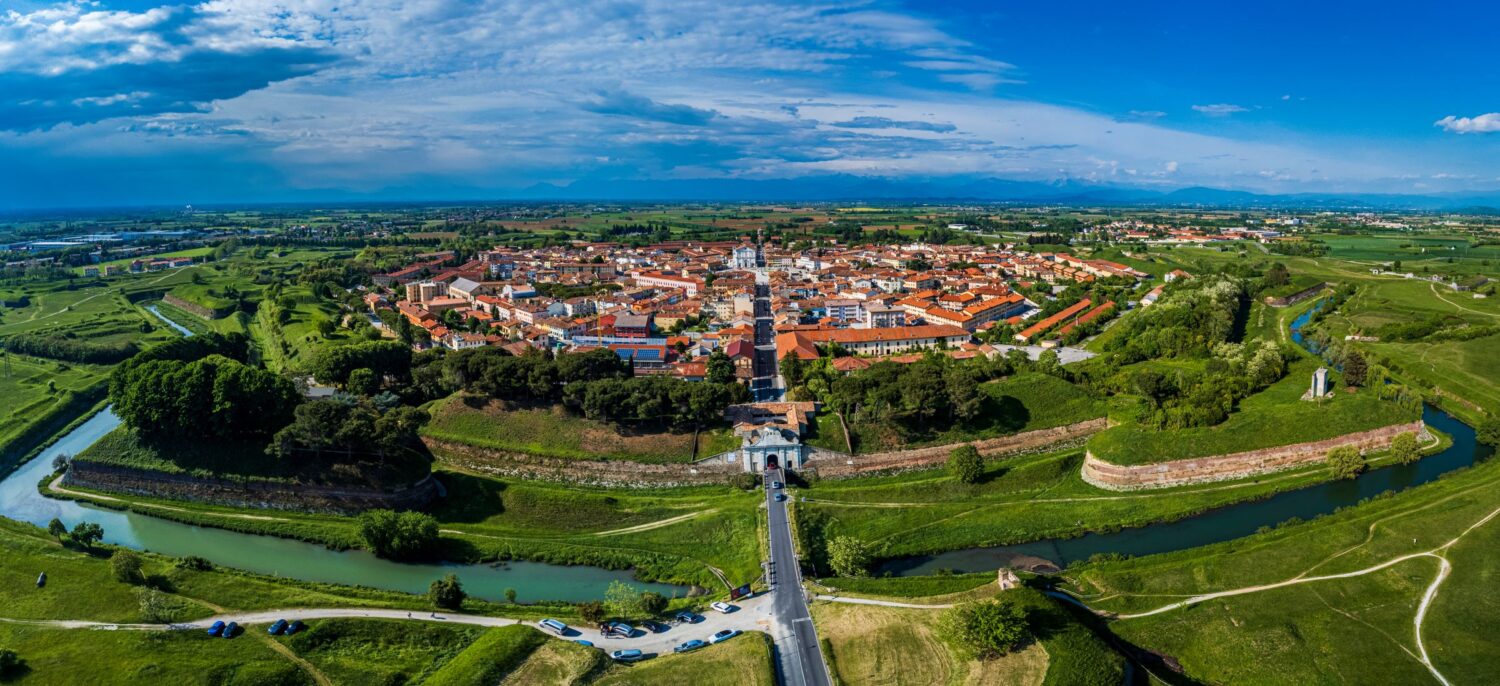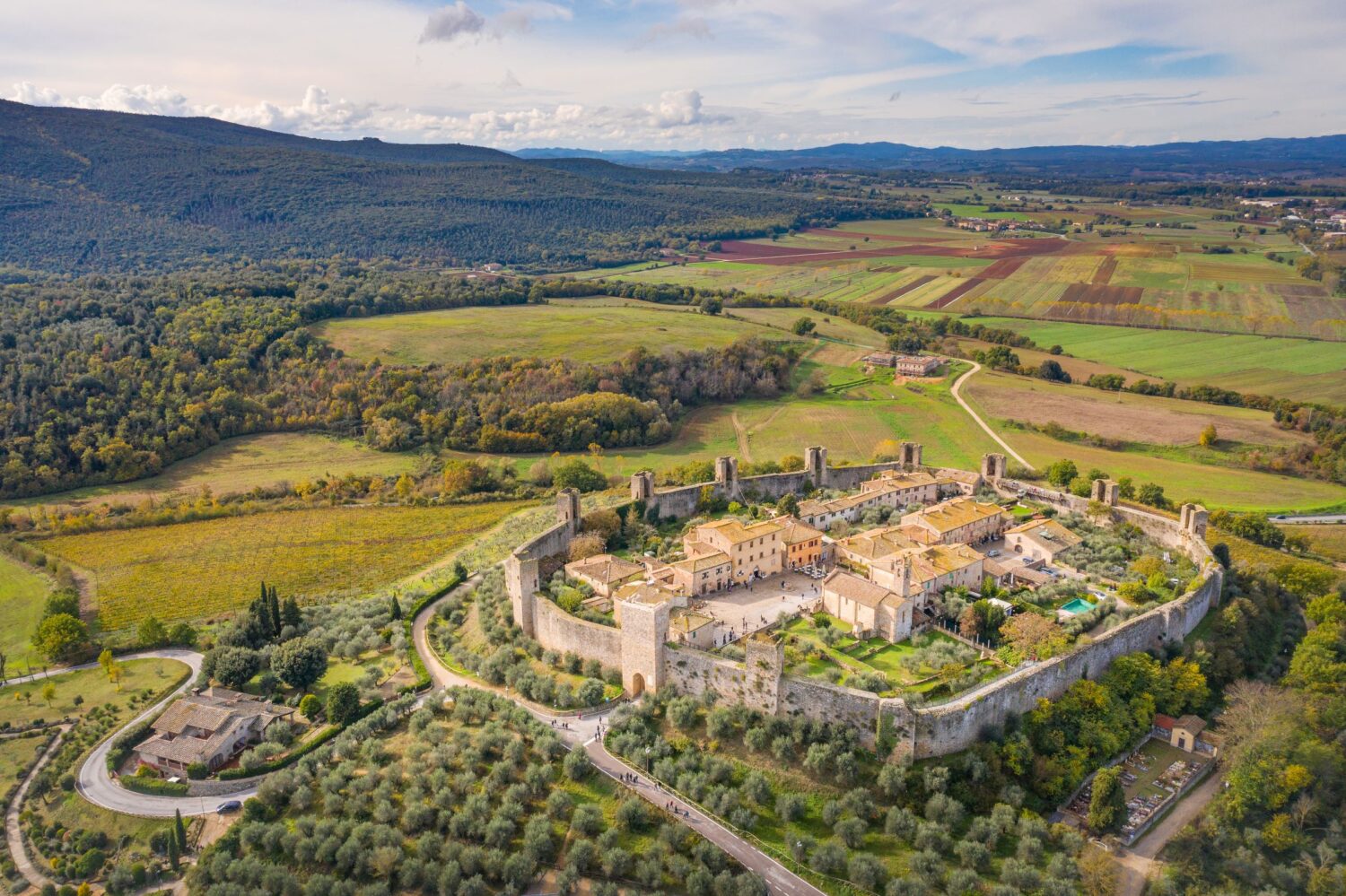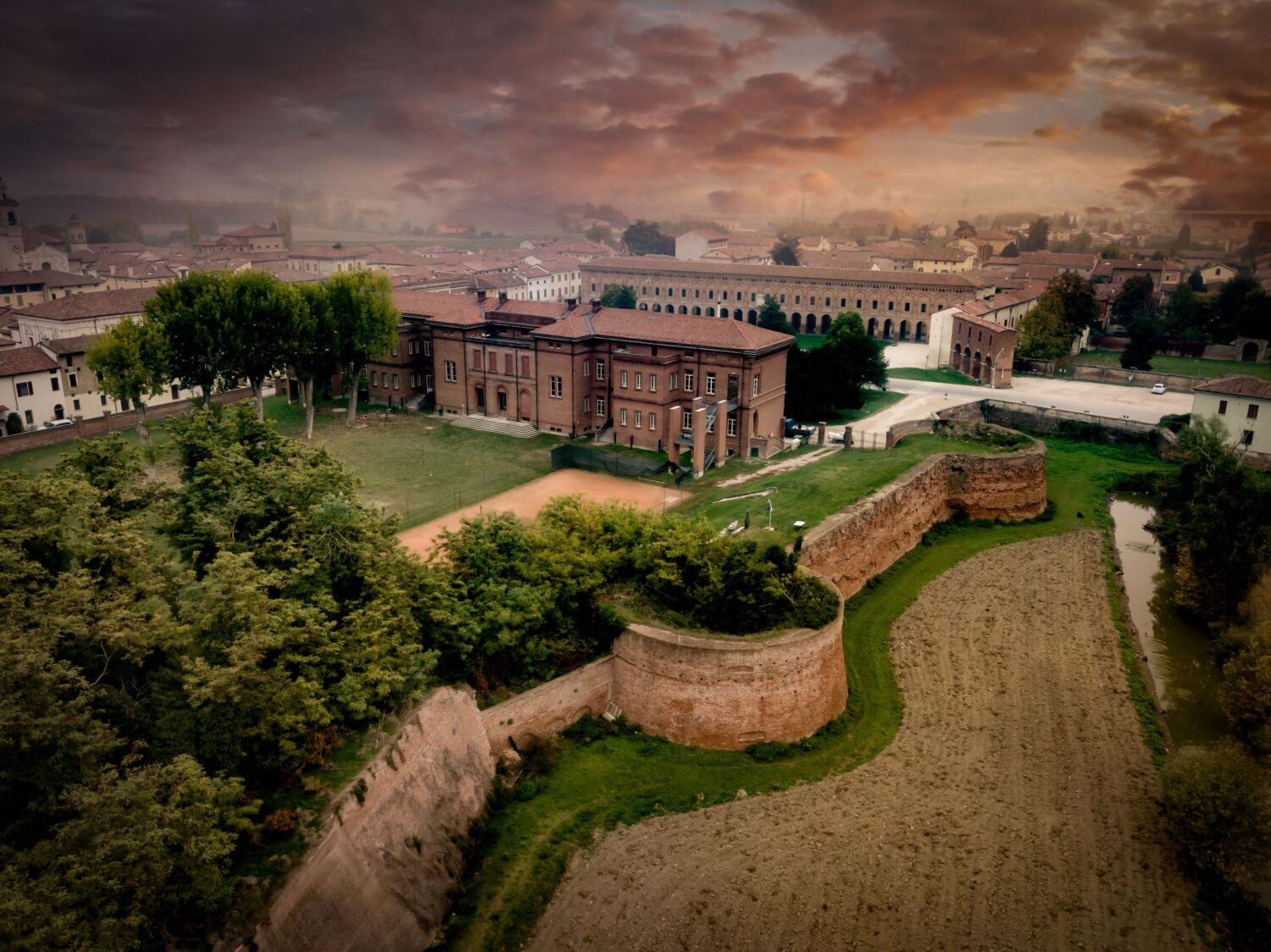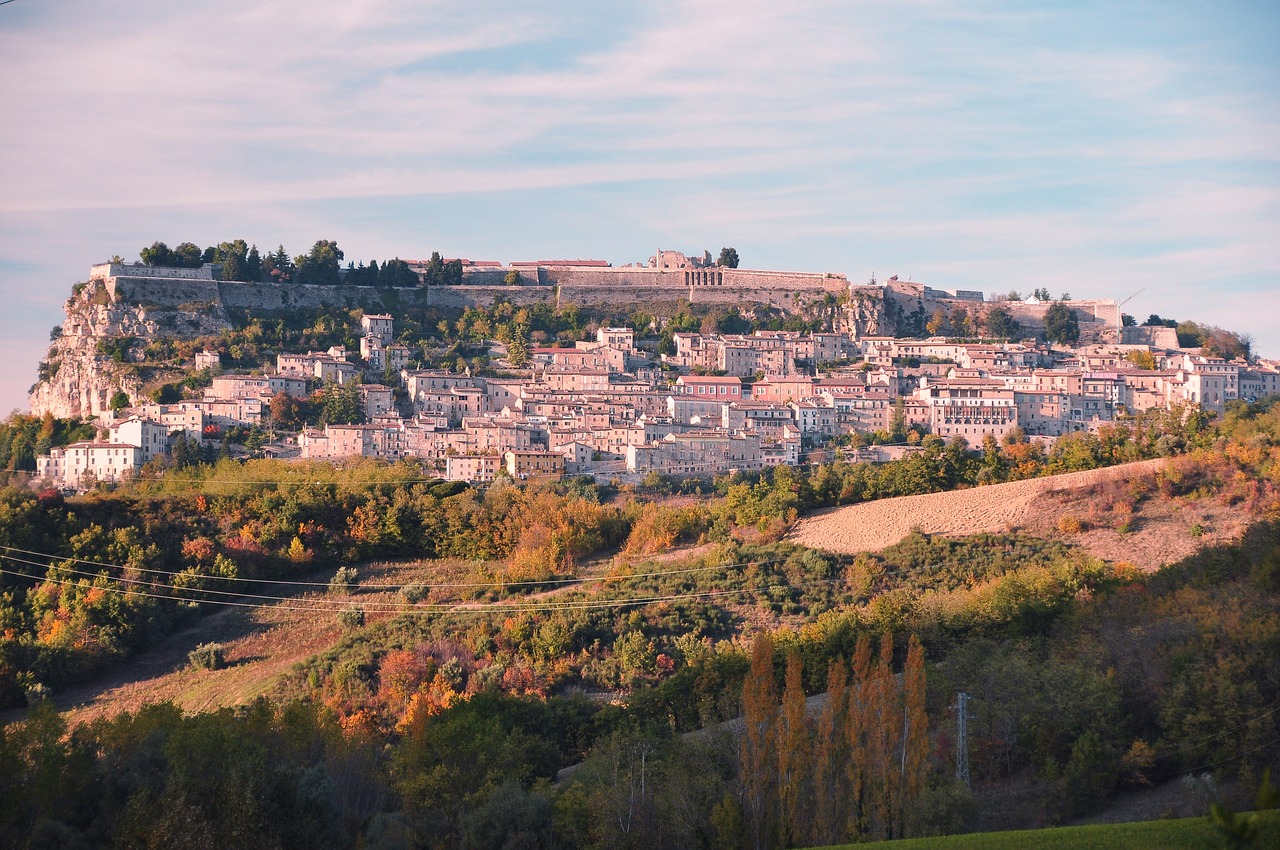Reading time: 9 minutes
Don’t let the title of this article mislead you; let there be no mistake, there are many more than just five fantastic medieval walled towns and cities in Italy. We have chosen five that are perhaps off the beaten path of the “typical” tour of Italy. From northern to central Italy and across five of the country’s twenty regions, we have compiled our top five recommendations with just the right amount of information to help you start planning.
Palmanova in Udine, Friuli-Venezia Giulia
This famous “starred city” as it is called in Italian, was constructed as a nine-point star by the Venetians in 1593. The “Most Serene Republic” is credited with the two internal concentric walls with nine bastions and nine ravelins, whereas, it was Napoleon who constructed the third or most external wall in the early nineteenth century. Its purpose in the sixteenth century was to defend the Friuli region against Turkish raids and from Habsburg expansion. In 2017, Palmanova was declared a UNESCO World Heritage Site and is also one of the Most Beautiful Villages of Italy.

There are over four kilometers of walls as well as three gates from which to enter this impressive fortified city. Once inside, you can happily lose yourself in the maze of tunnels and piazzas, including Piazza Grande in the shape of a perfect hexagon. Main sights include the Doge Cathedral, the Palace of the Superintendent General, Loggia of the Gran Guardia, Loggia of the Mercanti, and the Palazzo del Monte of Pietà.
Palmanova is easy to reach by car or train. It is off the A4 autostrada (from Venice or Trieste), the A23 (from Udine or Tarvisio), or State road 352. By train, it is on the Udine-Cervignano del Friuli line.
Read more on Palmanova
Monteriggioni in Siena, Tuscany
Just 20 kilometers from the Tuscan art city of Siena lies the magnificent hilltop village of Monteriggioni. You will feel as if you have stepped back in time into Medieval Tuscany, especially if you happen to visit in July (read on for details). Built by the Sienese in 1214, in order to defend themselves against Florence and the battles constantly being waged, Monteriggioni was an extremely important stronghold. It might surprise you to know that about 300 years later, the keys to the city were basically handed over to the Medicis when Monteriggioni surrendered.
There are a total of fourteen towers and two gates- one facing Rome, and the other facing Florence- in the 570 meters of walls that still surround the town. By purchasing a ticket, visitors can walk along the perimeter of the walls with splendid views of the Val d’Elsa, Chianti region, and the towers of San Gimignano. There is a very simple, Romanesque church and public gardens that were cultivated to feed the townspeople. Loads of quaint shops filled with souvenirs, artisan crafts, and culinary delights line the few streets of the village.

Every July Monteriggioni is catapulted back into the Middle Ages with its annual Medieval Festival. Historical reenactments, parades, traditional dance, music, and food delight guests of all ages.
Note that although it is definitely off the beaten path of Tuscany’s major art cities, it can still become surprisingly crowded during the peak tourist months of May through September. There is no train station (the closest station is 3 km away, Castellina Scalo), but because it is along the popular Via Francigena pilgrim route and the Via Romea Sanese cycling route, many visitors arrive on foot or on bike. There is a convenient car and camper park just outside the city walls should you choose to arrive by car.
Read more on Monteriggioni
Sabbioneta in Mantua, Lombardy
Just thirty kilometers from the major Lombard city of Mantua (Mantova) and the Emilian city of Parma, lies the walled village of Sabbioneta. Both a UNESCO World Heritage Site and one of the Most Beautiful Villages of Italy, this city’s fortification dates back to the eleventh century. It was the Gonzaga family who completely revamped the castle and the impressive three kilometers of walls in the sixteenth century. In just thirty years, Vespasiano Gonzaga Colonna transformed the city into an ideal Renaissance city or a Novella Roma.

If you visit today, you will be swept away by Sabbioneta’s infinite allure. You can enter either through west-facing Porta Vittoria, completed in 1567, or Porta Imperiale, completed in 1579 and facing Mantua.
There are some truly impressive monuments to see while you are here including the Teatro all’Antica designed by Vincenzo Scamozzi in 1588 and a testament to the glory of the Roman Empire. It is the second-oldest surviving indoor theater in the world and one of three Renaissance theaters still standing in the world.
One of the most photographed and symbolic monuments is the Gallery of the Ancients, also known as the Great Corridor. It is an awe-inspiring corridor composed of twenty-six arches and the third largest in Italy after the Gallery of Maps in the Vatican and the Uffizi in Florence. The interior is magnificently frescoed and was once filled with Vespasiano’s extensive collection of marble busts and epigraphs from antiquity that are now housed in the Ducal Palace and Museo Civico in Mantua.
Find out more about Sabbioneta and its numerous cultural events throughout the year by visiting its official tourism website.
There is no train station in Sabbioneta but you can arrive by bus from either Parma or Mantua or by car.
Civitella del Tronto in Teramo, Abruzzo
It is very likely that you have never even heard of Civitella del Tronto, also one of the Most Beautiful Villages in Italy, and it is just as likely that you had no idea it has the largest fortress in all of Italy. Built by King Philip II of Spain in the sixteenth century, this architectural marvel is a whopping 25,000 square meters. Today, aside from the awesome views that reach as far as the Apennine peaks of Gran Sasso and Majella, visitors can also enjoy the museum of medieval armory and ancient maps housed inside.
Civitella del Tronto’s walls likely date to the Angevin period and three gates to the city are still present today. The most striking example, and the most well-preserved, is thirteenth century Porta Napoli constructed of local travertine stone and proudly boasting the city’s coat of arms.

The town is extremely charming with its complex maze of alleys and arches and as it just so happens, the narrowest street in all of Italy, La Ruetta. Don’t miss the Church of San Lorenzo and the Church of San Francesco as well as the Abbey of Montesanto just outside the city.
We suggest driving through this beautiful area of Abruzzo as Civitella del Tronto is just a thirty-minute drive from the Adriatic Sea and equally as close to one of Italy’s most famous national parks, Gran Sasso and Monti della Laga.
Read more on Civitella del Tronto
Corinaldo in Ancona, the Marches
The medieval hamlet of Corinaldo is just twenty kilometers from the Adriatic coast, specifically the lovely seaside town of Senigallia. It is officially one of the Most Beautiful Villages in Italy and is very easy to fall in love with. The walls encircling the town date to the fourteenth and fifteenth centuries and are some of the best-preserved in the whole region.

One of the most characteristic sights of this walled city is what is known as La Piaggia, a ramp that climbs the entire town. Along the way, you’ll also stumble upon another one of Corinaldo’s famous landmarks, the Polenta Well. It was built to resemble the original fifteenth-century well and its history is so important to the townspeople that every July an entire festival revolves around it.
Read more on Corinaldo
So, there you have it: a brand new bucket list for your next Italian getaway! To think that these are only five of the many fortified cities in Italy. Stay tuned for more!

